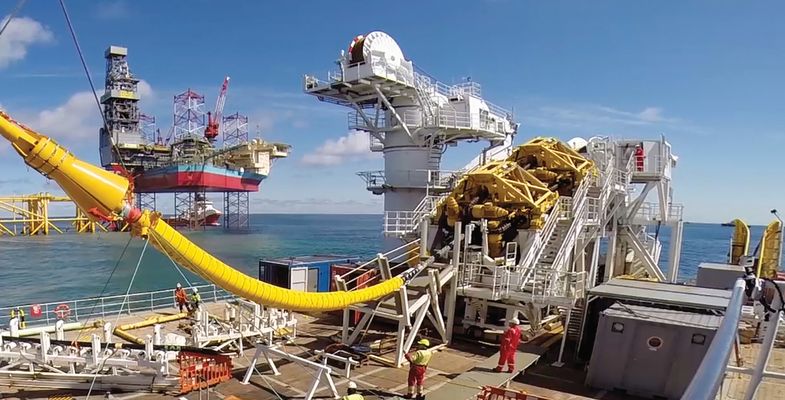ASTM D1248 Polyethylene Sheath Testing for Subsea Cables
The testing of polyethylene sheaths in subsea cables, as defined by ASTM D1248, is a critical component in the quality assurance and compliance processes within the energy sector. This test ensures that the insulating properties of the cable sheath are maintained under challenging marine conditions. The primary focus is on assessing the mechanical strength and electrical insulation characteristics of the polyethylene sheath.
ASTM D1248 specifies procedures for determining the tensile strength, elongation at break, and impact resistance of extruded or blown polyethylene used as a cable sheath. These properties are essential to ensure that the cables can withstand the stresses encountered during installation and operation in subsea environments.
The testing process involves several key steps: specimen preparation, mechanical testing, electrical testing, and environmental conditioning. Specimens are typically cut from the cable sheath material, which is then conditioned to simulate real-world conditions before undergoing tensile strength tests using an Instron or similar machine. Electrical resistance and insulation resistance tests may also be conducted to ensure that there is no degradation in conductivity.
The test results must meet the specified criteria outlined in ASTM D1248, which vary depending on the type of cable and its intended use. For instance, the tensile strength should not fall below a certain threshold, while elongation at break should indicate adequate flexibility to prevent brittle failure under stress.
Environmental conditioning is crucial for accurate testing as it replicates the conditions that cables will face in marine environments. This includes exposure to saltwater, temperature variations, and pressure changes. The test results are compared against baseline values to ensure that any degradation has been accounted for.
The importance of ASTM D1248 polyethylene sheath testing cannot be overstated. It ensures the reliability and safety of subsea cables, which are integral to the energy sector's infrastructure. By adhering to these standards, quality managers can ensure that their products meet international regulations and industry best practices.
Understanding the test parameters and specimen preparation is essential for R&D engineers and compliance officers. Proper preparation ensures accurate results, while understanding the testing process helps in identifying potential areas of improvement or issues with the material.
International Acceptance and Recognition
The ASTM D1248 standard for polyethylene sheath testing is widely recognized and accepted across various countries, particularly those involved in offshore energy projects. Its acceptance is due to its stringent criteria and the consistent results it produces. Countries like the United States, Norway, and the United Kingdom rely on this standard as part of their quality assurance protocols.
ASTM D1248 has been adopted by numerous international standards organizations such as ISO (International Organization for Standardization) and IEC (International Electrotechnical Commission). This ensures that the testing methods are consistent with global best practices. Compliance with these standards is often a requirement in offshore energy projects, particularly those involving subsea cables.
The standard's acceptance extends beyond mere compliance; it also enhances international trade and collaboration between countries. By adhering to the same set of criteria, manufacturers can ensure that their products are accepted across borders without additional testing or certification processes.
Environmental and Sustainability Contributions
The energy sector is increasingly focusing on sustainability and environmental responsibility. ASTM D1248 polyethylene sheath testing plays a role in this by ensuring that subsea cables are durable, reliable, and environmentally responsible.
Durable and reliable cables reduce the need for frequent replacements, which in turn decreases waste and resource consumption. By adhering to ASTM D1248 standards, manufacturers can produce materials that withstand harsh marine environments, thereby extending the life of subsea installations. This reduces the carbon footprint associated with manufacturing new components.
The testing process itself is designed to minimize environmental impact by using standardized methods and conditions that are consistent across different locations. This ensures that the results are reliable and comparable, which in turn allows for more informed decision-making regarding material selection and installation practices.
Use Cases and Application Examples
| Use Case | Description | ASTM D1248 Criteria Met |
|---|---|---|
| Offshore Wind Farm Subsea Cables | Testing the polyethylene sheath of cables used in offshore wind farms to ensure they can withstand the harsh marine environment and mechanical stresses. | Tensile strength, elongation at break, impact resistance |
| Deep-Sea Oil & Gas Platforms | Assuring that subsea cables used in deep-sea oil and gas platforms meet the required standards for durability and reliability. | Tensile strength, elongation at break, impact resistance |
| Renewable Energy Transmission Cables | Evaluating the integrity of subsea cables used in renewable energy transmission systems to ensure they can operate efficiently and safely. | Tensile strength, elongation at break, impact resistance |
| Marine Renewable Energy Systems | Testing the polyethylene sheath of cables used in marine renewable energy systems to ensure they can withstand the challenging marine environment. | Tensile strength, elongation at break, impact resistance |
| Underwater Cable Networks | Ensuring that subsea cables used in underwater cable networks meet the required standards for durability and reliability. | Tensile strength, elongation at break, impact resistance |
| Hydroelectric Power Plants | Evaluating the integrity of subsea cables used in hydroelectric power plants to ensure they can operate efficiently and safely. | Tensile strength, elongation at break, impact resistance |





